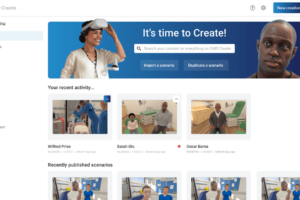VR Scenario Building Made Easy with an Intuitive Authoring Platform: OMS Create
Oxford Medical Simulation (OMS) designs, builds, and delivers immersive virtual reality (VR) experiential learning opportunities for healthcare students and practitioners. OMS offers learners access to over 240 clinical healthcare simulation scenarios both in-headset and on-screen. These scenarios can be run in person with supervision, or learners can remotely work through clinical simulations at their own pace, any time or anywhere. This HealthySimulation.com article will explore Oxford Medical Simulation’s no-code virtual clinical scenario authoring platform, OMS Create and how simulation programs can quickly and easily design custom scenarios!
What to Know About OMS Create
OMS Create is an intuitive tool that provides a framework for anyone looking to make changes to a VR simulation – regardless of prior authoring experience. The term “no-code” simply means that the simulationist does not need to know how to write code to use the OMS Create authoring tool. Simply drag and drop, add, or delete elements with the click of a button.
Sponsored Content:
Whether looking to make slight adjustments or reshape an entire scenario, OMS Create is equipped with all the advanced tools anyone needs and provides the flexibility to completely customize any scenario of the educator’s choice, making the possibilities endless.
To get the most out of OMS Create, the simulation educator must first determine the learning objectives and goals. The next step is to dive into OMS Create to get familiar with the platform and tools to start changing a scenario to meet the goals and objectives. Smaller changes, like quick adjustments to vital signs, can be done and published in minutes. The simulation educator can also build out much larger changes, like reconstructing the flow of a scenario.
View the LEARN CE/CME Platform Webinar Immersive Learning: Integrating VR Simulation and Continuity of Care in Nursing Educationto learn more!
What Can Clinical Simulation Educators Do With OMS Create?
Sponsored Content:
Below are a few examples of common ways simulation educators can use OMS Create to edit scenarios:
Changing the Level of Difficulty : Interested in revisiting a case as learners develop a larger knowledge base? OMS Create allows clinical educators to expand upon or change the difficulty level of a scenario, using the same case to meet different learning objectives. One way to change the complexity of a case is to make a differential diagnosis harder or easier to determine by changing actions in the scenario.
For example, in a scenario involving a patient with anaphylaxis, the clinical educator might want to remove one of the patient’s symptoms or signs to widen the potential differential diagnoses learners must consider. The healthcare simulation educator can add or delete actions like these, change their order, or tie them to learners’ actions to make scenarios more or less challenging based on learner level. The simulation facilitator can also change when certain actions happen in the scenario and what causes them.
For instance, the facilitator may want the virtual patient to cough every 30 seconds versus adjusting the timing so that coughing happens randomly every 30-90 seconds. The clinical simulation educator can also create a checkpoint within the scenario to better understand a learner’s thought process. This can occur by adding a point for learners to stop, reflect, and provide rationale for their actions. The simulation educator can choose when this checkpoint happens and what questions learners will answer.
Changing Physiology: Should the virtual patient appear more or less unwell? The healthcare educator can adjust vital signs, accelerate or slow a patient’s deterioration, or change the patient’s physiologic response based on the action taken. This is possible thanks to the dynamic physiology engine that underlies each OMS scenario.
For example, if the learning objectives are around the early recognition and treatment of sepsis, the simulation educator may choose to have the virtual patient deteriorate more quickly. If the educator wants to make the effects of treatment more or less obvious, the simulationist might exaggerate the patient’s vital signs following a correct or incorrect treatment option. This area is free for the simulation facilitator to play with, so the virtual patient presents precisely as needed for the learners to meet their objectives.
Adjust Feedback and Scoring: Want to include personalized feedback for learners? While the OMS platform provides evidence-based feedback and a clinically-weighted scoring system with each scenario, the simulation educator is free to make changes to the feedback quickly and easily with OMS Create.
The clinical educator can change the weighting of certain actions to be more or less ‘critical’ and change the score associated with them to align with the intended rubric. The clinical educator can make the feedback as specific as possible, which can further support the learners by aligning the simulation with specific or nuanced learning objectives. This specificity can better reinforce learning and resonate more effectively with the learners.
Make it specific to Your institution: What if administrators need the facility’s protocols to be used within the scenario? With OMS Create, the simulation educator can upload their own guidelines, protocols, or procedures and have them easily accessible to the learners throughout the scenario. The simulationist can also change medications and doses to match those used in the clinical training institution. In this way, learners can work according to the standards they will be accustomed to within the facility, keeping learning objectives aligned with real-world expectations around practice.
Produce new scenarios: Looking for a heavier lift in producing your own unique scenarios? With OMS Create, the simulation educator can make big changes to scenarios and create a flow of their own. The simulationist can change all the audio, upload completely new voice recordings, or change one scenario to fit entirely different learning objectives.
For example, take a case that starts with a virtual patient who is presenting with pneumonia. The simulation educator can make the initial presentation of pneumonia actually develop into a case of sepsis, or make a completely different presentation and diagnosis to meet the identified learning needs. The simulationist can rewrite how a scenario works using OMS Create. This is akin to authoring their own scenario, but with a foundation to work off of, so there is no need to build something entirely from scratch.
Delivering VR Clinical Simulations at Scale
Whether interested in working on clinical decision-making and leading a case, developing interprofessional collaboration, or transitioning to practice – Oxford Medical Simulation provides evidence-based, immersive VR learning opportunities for students and practitioners alike.
The OMS platform houses a continually growing library of over 240 scenarios, covering topics ranging from fundamentals to subspecialties like emergency care, pediatrics, and community-based care. Simulations are created by an in-house team of Clinical Authors who have experience in direct patient care and ensure scenarios are aligned with standards of best practice. Scenarios also go through a detailed peer review process to ensure accuracy and validity. There are lots of ways to interact with these scenarios:
- Individually lead a case from start to finish
- Collaborate with an interprofessional team
- Hone communication skills by talking with AI-powered virtual patients or family members
- Practice psychomotor skills with hands-on training
- Manage multiple patient cases at once, ranging from one up to five patients
Starting with such a robust foundation, simulation educators can easily make scenarios their own with OMS Create. To learn more about how to leverage OMS Create to meet most clinical simulation educator’s needs, book time to speak with OMS or reach out with any questions.
Learn More About The OMS Create VR Scenario Design Tool
Lance Baily, BA, EMT-B, is the Founder & CEO of HealthySimulation.com, which he started while serving as the Director of the Nevada System of Higher Education’s Clinical Simulation Center of Las Vegas back in 2010. Lance is also the Founder and acting Advisor to the Board of SimGHOSTS.org, the world’s only non-profit organization dedicated to supporting professionals operating healthcare simulation technologies. His co-edited Book: “Comprehensive Healthcare Simulation: Operations, Technology, and Innovative Practice” is cited as a key source for professional certification in the industry. Lance’s background also includes serving as a Simulation Technology Specialist for the LA Community College District, EMS fire fighting, Hollywood movie production, rescue diving, and global travel. He and his wife Abigail Baily, PhD live in Las Vegas, Nevada with their two amazing daughters.
Sponsored Content:



















